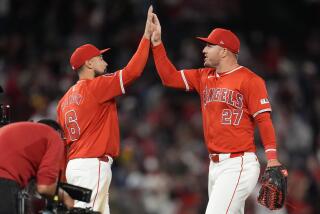Erick Aybar and Maicer Izturis look to replace Chone Figgins as Angels’ leadoff man
- Share via
Reporting from Tempe, Ariz. — If you combine Erick Aybar’s speed and durability with Maicer Izturis’ plate discipline and consistent contact, you might produce a hybrid player who is a reasonable facsimile of Chone Figgins, one of baseball’s best leadoff hitters.
That is why it might take two top-of-the-order hitters to replace Figgins, the highly productive third baseman who left to sign a four-year, $36-million deal this winter with the Seattle Mariners.
“Ideally, you’d like to have one guy anchored in the leadoff spot -- it makes it better when you have guys who are into their roles, and the lineup becomes clean,” Manager Mike Scioscia said. “But when you talk about setting the table, it comes down to production. If you have to mix and match, you can still get it done.”
The Angels don’t need or expect Aybar, a shortstop, or Izturis, a utility infielder who will battle for the third base job this spring, to match the 2009 season of Figgins, who hit .298 with a .395 on-base percentage, 114 runs, 101 walks and 42 stolen bases.
In fact, they would gladly plug the 2009 seasons of Aybar (.312 average, .353 on-base, 70 runs, 58 runs batted in, 14 stolen bases) and Izturis (.300 average, .359 on-base, 74 runs, 65 RBIs, 13 stolen bases) into their leadoff spot right now and take their chances.
“There are two very exciting choices,” Scioscia said. “Maybe they’ll get it done a little differently. One guy [Izturis] might work counts a little better because of his experience, but Erick is a guy who, with experience, will do some things more consistent that will make him a more dynamic guy at the front of the lineup.”
Aybar is so fast that balls he hits into the right-center field gap are often easy triples, and he routinely goes from first to third on singles.
That blazing speed, combined with the significant strides he made in plate discipline in 2009 and his firm grip on the shortstop job, will probably earn Aybar first crack at leadoff.
“I think I can do it, and I will work hard at it,” said Aybar, the 26-year-old defensive whiz from the Dominican Republic. “I’ll try to look at more pitches, work counts, get on base more. I don’t want to change myself. I just want to get better at what I’ve been doing.”
Aybar, a switch-hitter, used to be as much of a free swinger as Vladimir Guerrero but without power. In 2008, Aybar hit .277 with a .314 on-base percentage, drew only 14 walks in 346 at-bats and saw an average of 3.26 pitches per plate appearance.
But with veterans such as plate-discipline guru Bobby Abreu and Torii Hunter mentoring him last year, Aybar’s average and on-base percentage improved dramatically -- he drew 30 walks in 504 at-bats and saw an average of 3.47 pitches per plate appearance.
“Figgy told me, ‘Hey, I might not be here next year, so you need to be ready to lead off,’ ” Aybar said. “I watched him a lot last year, and I put more preparation time into watching video every day, in the clubhouse, at the house, in planes.
“And every game, I’d sit in the dugout with Bobby and he’d talk about how the pitcher was throwing, what to look for in certain counts, whether you need to be aggressive or take pitches and get on base. He helped a lot. Hunter did too.”
Scioscia does not expect Aybar to develop into a prototypical leadoff hitter overnight. “He might not get on base like some guys he’ll be compared to,” Scioscia said. “But he’ll get on base a lot, and when he does, he’s going to make it count.”
Aybar may have more upside as a leadoff hitter, but Izturis, the 29-year-old switch-hitter from Venezuela, has more experience and might be more immediately suited for the role.
Aybar has led off eight times in his big league career, batting .333 (eight for 24) with no walks; Izturis has led off 47 times, batting .259 (49 for 189) with 18 walks and a .329 on-base percentage.
“For me, that’s part of my game -- I’ve hit first or second my whole minor league career, and I did it a lot when Figgy was hurt,” Izturis said. “I don’t change my game. I go to the plate with a plan, whether I’m hitting first, second or ninth.”
Izturis is a career .327 hitter with runners in scoring position, and he struck out only 41 times and walked 35 times in 387 at-bats last season. He averaged 3.82 pitches per plate appearance.
“Leading off, I try to show the guys behind me what kind of stuff the pitcher has, I try to make him throw more pitches the first two or three innings,” he said. “Figgy was a great example to follow.”
Like Figgins, Izturis can play third, second and shortstop at a high level. Unlike Figgins, Izturis has never seized one position for an entire season, but that might not hurt his chances of being an everyday leadoff man.
Even if Izturis doesn’t beat out Brandon Wood for the third base job, he is expected to share time with Wood at third and with Howie Kendrick at second, and spell Aybar occasionally at short. As a super utility player, Izturis could easily start four to six games a week.
A bigger obstacle to an everyday leadoff role for Izturis is health -- he missed considerable time in 2006, 2007 and 2008 because of hamstring and lower-back injuries, though he avoided the disabled list last season.
“I don’t feel we have to be more careful with him,” Scioscia said. “He held up very well last year. I don’t anticipate putting a governor on him at all.”
No matter what, the Angels expect to have a spark plug at the top of the order.
“Aybar’s speed is amazing, and he got better at working counts last year -- I don’t think he’ll have any problem doing it,” Abreu said. “And Izturis can hit, no doubt. He’s very smart at the plate, he can steal bases and score runs. He’s going to be a big influence on the lineup.”
mike.digiovanna@
latimes.com
More to Read
Go beyond the scoreboard
Get the latest on L.A.'s teams in the daily Sports Report newsletter.
You may occasionally receive promotional content from the Los Angeles Times.







